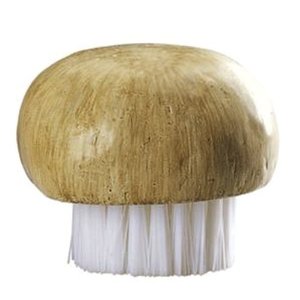
In case that question has been keeping you up at night, as it has me.
Quite seriously, now, because this is literally a matter of life and death for your entire family: I find this object interesting from an aesthetic perspective.
At first glance, of course, it’s easy to lump brushes that look like mushrooms together with tape dispensers that look like elephants, fireplace lighters that look like giant matchsticks, pocket knives that look like spaceships, and similar “looks-like” product designs that are at best “cute” and at worst anti-functional or even dangerous. In the past, I have referred to such products as “pseudomorphs,” mostly because “stuff what looks like other stuff, what it ain’t” is unwieldy and not as impressive. But that’s basically the idea. I dislike decoration for its own sake, especially in utilitarian objects, and find going out of the way to make a tool look like some object from nature, for instance, to be especially frivolous.
However, this “mushroom brush” is an interesting exception, a rare example of functional pseudomorphism. Consider: As any mycophile will tell you, fresh mushrooms (especially exotic varieties) should not be washed, in order to best preserve their flavors. To remove dirt and other debris before preparation, brushing is the preferred method, and to keep things hygienic one should dedicate a brush to the purpose. You do not, after all, want to clean mushrooms with the same brush you use to scrub dishes or clean under your fingernails.
And to avoid confusing your mushroom brush with these other, lesser, nastier brushes, it should be distinctive, somehow. You could label it, of course, perhaps with the words “mushroom brush,” but then you’re reduced to written language, which only works when everyone is literate in the same one. But what about children, illiterate adults, and/or the French? What about your potential mushroom-brush customers in all those other, lesser, nastier countries of the non-English-speaking world? You can add a bunch of labels in a bunch of languages to every brush, or you can sell a bunch of differently-labelled brushes in a bunch of differently-labelled countries, or you can do away with using words altogether and just make the brush, itself, look like a mushroom, and thus unambiguously identify its function.
In other words, mushroom brushes that look like mushrooms are functionally superior to those that do not. Even a mushroom brush that is labelled with a picture of a mushroom is not as good, because, while that picture-label could conceivably be overlooked by a person in a hurry to find a brush to clean the toilet (as one so often is), no one is going to attempt to use a brush that actually looks like a mushroom without noticing the fact.
Whew. I think I might be able to sleep, now.
And if, tomorrow morning, when I reach for my mushroom-shaped mushroom brush to tenderly waft away the clinging flakes of loam from my daily pound of breakfast morels, I should take the tiniest bit of childish pleasure in the fact that my brush looks like something what-it-ain’t, well…I guess that might be OK, too.
